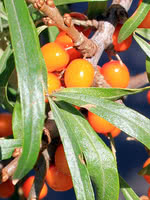Mon-Fri 9am - 5pm Mountain time
Common Snowberry vs Sea Buckthorn (Seaberry)
Hippophae rhamnoides l.
Symphoricarpos albus
Sea Buckthorn, aka Seaberry, is a nitrogen fixing shrub that produces attractive berries high in vitamin C.
While we can't confirm claims that the berries are effective in treating various ailments, many people believe consuming the berries helps with arthritis, infections, and asthma, among other things.
Sea Buckthorn plants have attractive pale silvery-green leaves, dense branches, and large thorns, people like to grow in ornamental hedges or as a first row in a shelterbelt.
Note: these plants typically reach maturity and make their sex easily known (females producing fruit) in their 3rd or 4th year of growth. Our seedlings are too young to identify their sex.
Common Snowberry is a small deciduous shrub with characteristic white to pink flowers and clusters of white fruit.
This North American native species is very adaptable, and can be used for erosion control in riparian and restoration areas. Snowberry's fruit attracts wildlife, and livestock can consume the berries without issue.
Sea Buckthorn (Seaberry) Quick Facts
Common Snowberry Quick Facts
Toxicity: berries toxic to humans
In row spacing: 0.9 - 1.2 m (3 - 4 ft)

